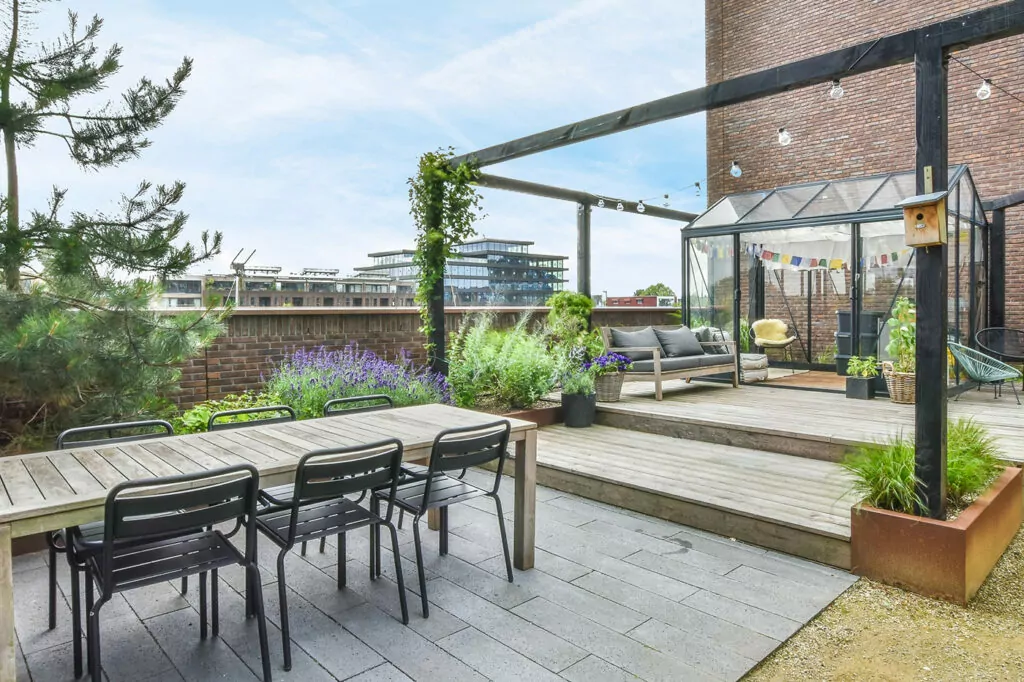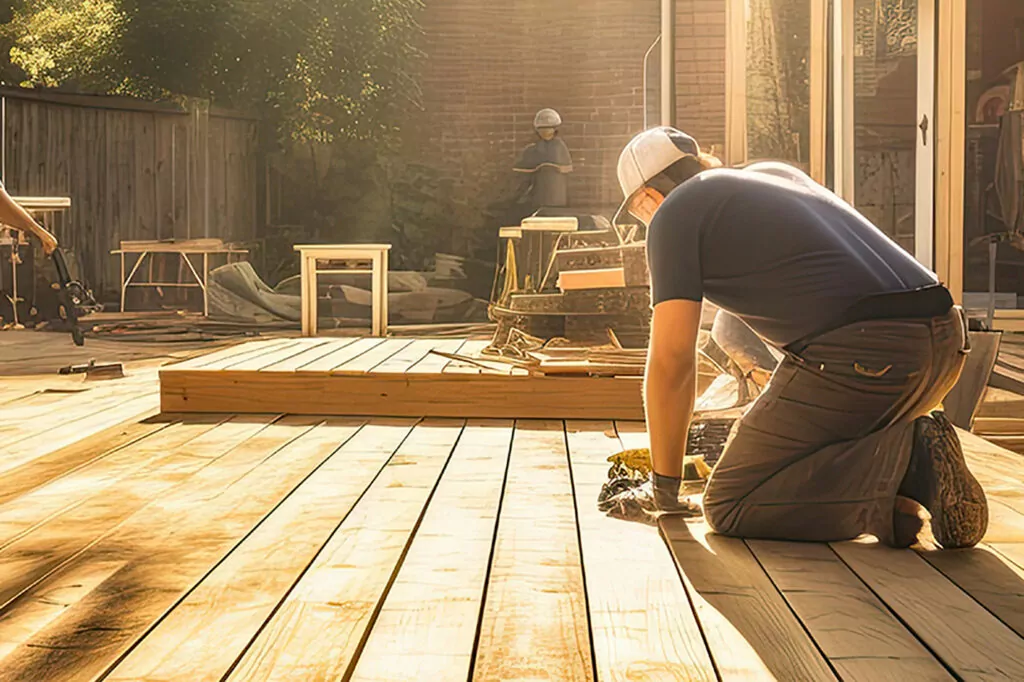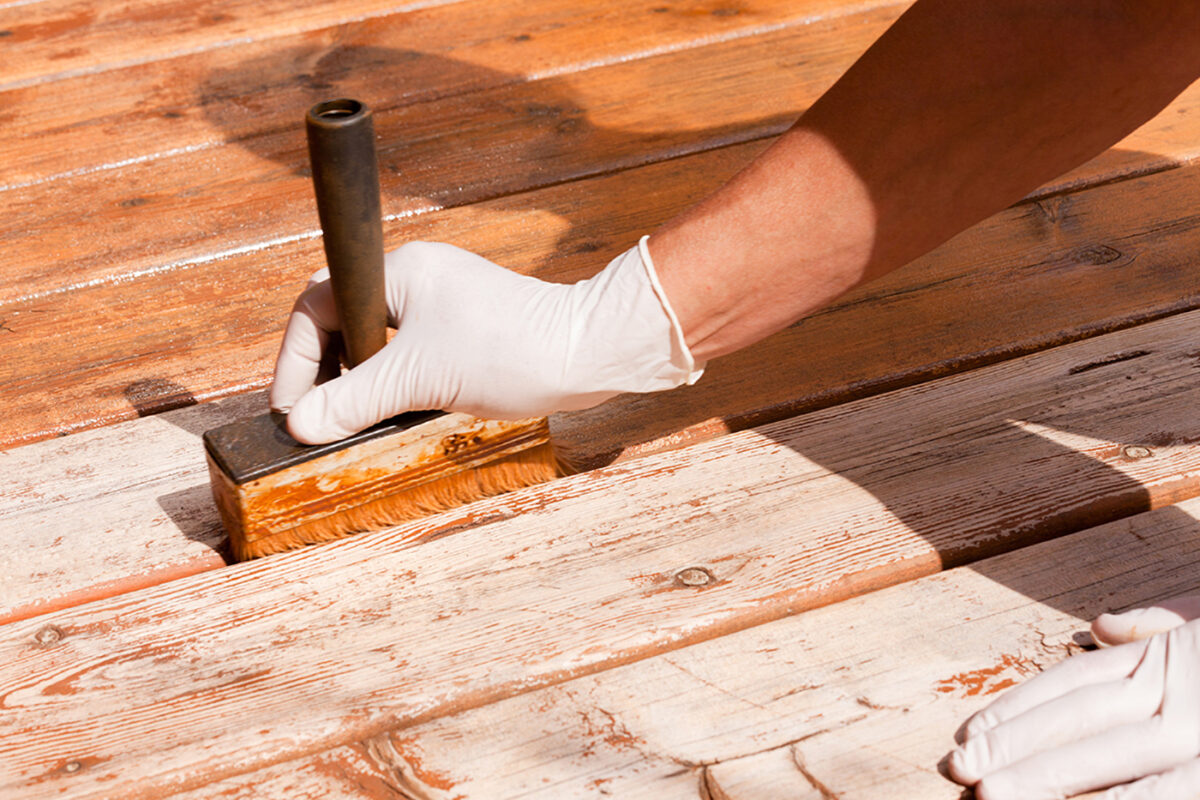Refreshing your outdoor living space with a new coat of deck paint can revitalize the entire area and add major curb appeal. However, calculating the cost of painting or staining a deck requires you to consider multiple factors. For a professional job, expect to pay anywhere from $500 to $2,000 or more depending on the deck’s size, the deck’s condition, materials used, and any needed repairs.
This guide explores all the key factors that affect pricing, from reasonable material costs to typical labor rates for stripping, priming, and painting. You’ll also find money-saving tips on tackling preparation yourself versus hiring pros, the benefits of investing in quality stains and paints, and how to budget for this valuable outdoor upgrade.
Difference Between Painting and Staining
When it comes to reviving the look of your wood deck, you’ll need to decide between painting or staining it. These two options have distinct differences in terms of their look, application process, and associated costs.
Deck Staining

Staining is the more popular and cost-effective choice for many homeowners with wood decks. The cost to stain a deck is generally lower than painting deck surfaces, as it requires less labor-intensive prep work. Staining allows the natural wood grain to show through while protecting against moisture and UV damage.
Stains come in solid, semi-transparent, and clear formulas to let you choose how much of the deck material you want visible. They soak into the wood rather than forming a topical layer like paint. This makes staining ideal for older or severely weathered decks that may not accept a smooth paint job well.
Deck Painting

Painting deck surfaces fully covers and conceals the wood deck material underneath. A fresh coat of exterior paint in your desired color can revive an old deck that’s seen better days or give a new deck a customized look. However, painting deck boards and railings require significantly more preparation.
Any old paint must be fully stripped or sanded, and the surface cleaned and degreased thoroughly before applying new oil-based paint. This intensive prep work by an experienced deck painter or deck repair professional increases the overall painting deck costs compared to staining.
While not as budget-friendly upfront, a quality paint job can provide longer-lasting protection than stains when combined with proper reapplication every few years. Painting is also recommended for decks with extensive damage that won’t hold stain evenly or for homeowners wanting to match their deck to exterior color schemes like pergola or siding colors.
Deck Painting Cost Factors
While the size of your deck is the biggest overall variable affecting costs, numerous other factors can impact the total price range for repainting deck surfaces or completing a full deck refinishing job. Major cost factors include:
1) Size of the Deck

The overall square footage of your outdoor deck is one of the biggest factors impacting material costs and project times required for repainting deck surfaces. Larger decks will naturally require more gallons of paint or stain and more labor hours to complete. Home improvement pros typically calculate outdoor deck paint costs on a per-square-foot basis.
2) Deck Material

The type of material your deck is made from can affect painting requirements and costs. Wood decks generally accept paint and stain well but may need more extensive sanding or deck refinishing if old coats of paint are chipping or wearing thin. Composite decks made from wood fiber and plastics may have special cleaning and compatibility requirements for certain paints.
3) Paint Type

There are differences in cost between water-based acrylic deck paints versus oil-based alkyd paints. Oil-based formulas tend to be more expensive but more durable. Adding specialized deck sealers can increase protection, but they can also increase project costs. The coverage rate (square foot per gallon of paint) will impact how much material is needed.
4) Deck Condition

The existing condition of your deck will greatly affect the amount of labor and prep work, including pressure washing, sanding with sandpaper, or repairs needed before painting. An old, weathered deck with splintered boards may need a full deck refinishing service factored into your overall cost.
5) Deck Design

More intricate deck designs with built-in planters, benches, railings, or multiple levels will increase time and labor costs for proper painting coverage compared to a simple rectangular deck. Accessing tight spaces may require additional tools like a sprayer.
6) Hiring vs. DIY

Whether you hire an experienced painting contractor or tackle the deck yourself as a DIY painting project makes a major difference in total costs. Homeowners can save significantly on labor by doing the work themselves if they have the time and skills.
7) Location

Costs can vary based on geographic region and local material/labor prices. Some deck painting contractors may charge more during peak seasons or have travel fees based on your location.
8) Weather Conditions

Ideal weather conditions like low humidity, no rain, and moderate temperatures are needed to apply deck paint or stain per manufacturer instructions. Unexpected delays due to weather can increase overall project costs.
Further Reading: 20 Covered Deck Ideas to Upgrade Your Space
How Much Does it Cost to Paint a Deck by Parts?
Many homeowners look to save costs by painting just certain sections or elements of their deck rather than doing a full repaint job. Painting a deck by its individual parts can allow you to prioritize the most visible or worn areas first. Typical deck part painting costs can include:
| Deck part | Cost |
| Deck boards | $3-$6 per square foot |
| Steps/stairs | $3-$6 per square foot |
| Railings/handrails | $3-$10 per linear foot |
| Porch spindles | $3-$10 per linear foot |
The costs for painting deck parts vs. the full structure can vary significantly based on the size, the accessibility of each component, and whether repairs or repainting over old finishes are required. Many homeowners start with highly visible railings, stairs, and spindles for a refresh before moving to larger deck board surfaces.
Consider Additional Costs

Beyond the basic costs of materials and labor, there may be additional potential expenses to factor in for your deck painting project:
- Number of coats: Most professionals recommend applying two full coats of paint or stain for proper coverage and protection. This can double your material costs compared to a single coat application.
- Custom paint job: If you want customized colors that require tinting the paint on-site or decorative techniques like stenciling, this will increase labor costs.
- Repairing deck boards/railings: Severely damaged, rotting, or worn deck boards and railings may need to be repaired or completely replaced before painting. Budget for new lumber and any necessary carpentry work.
- Power washing: Proper surface preparation is key for excellent paint adhesion. Most contractors recommend hiring a power washing service to clean the deck beforehand.
- Clearing the deck: You may incur costs to have existing furniture, planters, grills, and other items temporarily removed from the deck area before painting.
- Permits: Depending on local regulations, you may need to pay permit fees for larger exterior home improvement projects like deck painting.
- Wood conditioner: Using a specialized wood conditioner before painting can improve adhesion and longevity but also adds extra material cost.
By considering potential additional services from the start, you can ensure your budget accurately accounts for any required repairs, preparation, or extra services needed.
Tips to Reduce Costs

While painting or staining a deck can be a significant investment, there are some strategies to help reduce your overall costs:
- Choose the right paint: Avoid overspending on ultra-premium paints. Opt for affordable options with good coverage rates (sq ft per gallon).
- DIY prep work: Save on labor by handling cleaning, sanding, and basic repairs yourself before hiring pros for painting.
- Prioritize high-traffic areas: Paint stairs, railings, and main walking areas first if you can’t afford to paint the entire deck at once.
- Use your own tools: Reduce supply costs by using your own painter’s tools and materials.
- Time your project mid-season: Schedule painting in late spring or early fall to avoid peak season pricing.
- Maintain the paint job: Clean and reseal every 2-3 years to extend the life of your deck’s finish.
- Get multiple quotes: Obtain at least 3 quotes to find the best price from painting contractors.
With some strategic planning and sweat equity on prepping the deck, you can save significantly on professional painting costs.
5 Benefits of a Painted Deck

Giving your deck a fresh coat of paint or stain offers several key benefits beyond improving the aesthetic. Some of the major advantages include:
- Increased lifespan and durability: Quality paint protects deck wood from UV rays, moisture, mildew, and wear, extending its lifespan.
- Weather protection: Painted decks resist rain, snow, heat, and cold, preventing cracking, warping, and rotting.
- Enhanced curb appeal: A fresh coat of paint or stain revitalizes your deck, boosting your home’s exterior look.
- Low-maintenance finish: Painted decks need less maintenance, as the paint shields against dirt, mold, mildew, and UV damage.
- Added safety: Fresh paint with slip-resistant additives improves traction and prevents splinters, enhancing safety.
- Elevated outdoor living: A newly painted deck provides a vibrant, stylish space for entertaining, dining, and relaxing, enhancing your outdoor experience.
From ensuring increased durability to beautifying your yard, taking the time and investing in professionally painting your deck provides numerous practical and aesthetic benefits.
Further Reading: How To Install a Shade Sail: Step-by-Step
Painting or staining a deck revitalizes your outdoor space and protects wood surfaces from weather damage. Costs range from a few hundred dollars for a DIY stain to over $1,000 for professional painting. The benefits of deck painting include things like increased durability, more curb appeal, and a better outdoor experience.
Deck size, material, condition, accessibility, paint type, and necessary repairs or prep work affect total costs. Make sure to budget for add-ons like power washing or wood conditioners.
If you need assistance with any phase of restoring your deck’s luster, consider searching Taskrabbit’s network of deck painting and staining professionals. Skilled Taskers can handle every aspect of the job, from initial cleaning and preparation to the final painted finish.
Get a head start on reviving your outdoor entertainment area by booking a top-rated Deck Restoration Tasker on Taskrabbit today!
Deck Painting Cost FAQs

Can I paint over old paint on my deck?
You can paint over old deck paint/stain if it’s in good condition after cleaning and deglossing, but sanding/stripping is recommended for best adhesion.
Is it worth painting my deck?
Yes, painting or staining provides protection that greatly extends the life of your deck and enhances outdoor living.
Should I prime my deck before painting?
Applying a primer coat before painting is recommended, especially on bare wood decks, to maximize paint adhesion and longevity.
How long does a painted deck last?
With proper paint and maintenance, a newly painted deck can last 5-10 years before requiring a new coat.
What’s better for decks–oil or water-based paints?
Oil-based alkyd deck paints are usually more durable against peeling and moisture but require special solvents, while water-based acrylics are easier to apply.
Last updated on March 5, 2025 by Meghan Lalonde

























